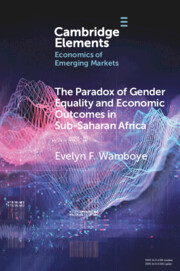Element contents
The Paradox of Gender Equality and Economic Outcomes in Sub-Saharan Africa
Published online by Cambridge University Press: 15 September 2023
Summary
- Type
- Element
- Information
- Online ISBN: 9781009371872Publisher: Cambridge University PressPrint publication: 05 October 2023
References
- 2
- Cited by



